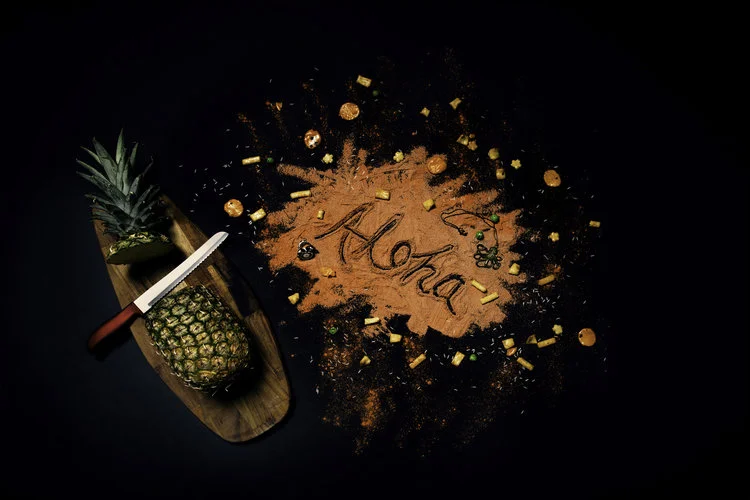Creative Direction: Jonathan Valdez
Photography: Blue Angel Photography
Although pineapples look like one juicy, scaly entity, they are actually a combination of dozens of flowers, each identified by their spiny hexagon like markings, that fuse together around the fruit’s center. With a fascinating nutritional profile and a unique tropical taste, pineapples are certainly worth a deeper look into their inner historical and nutritional core.
Origin of Pineapples
Pineapples are generally associated with the Hawaiian Islands, but their origins began in South America between Paraguay and Brazil. The sweet fruit was grown towards Mexico and the West Indies where Christopher Columbus discovered. Once discovered, he brought it back to Europe. This new fruit became a delicacy throughout Europe and it was then introduced Eastward to Hawai'i in the 16th century. It wasn't until the 1880s when John Kidwell, a trained Horticulturist, received credit for establishing the pineapple industry in Hawai'i. He grew a variety of pineapples but settled on the “Smooth Cayenne” variety for its uniform texture and cylindrical shape. In 1889, the commercial Hawaiian pineapple canning industry began with Kidwell’s associate, a native to Honolulu. In 1899, James Dole moved to Hawai'i and started his own pineapple plantation, exporting the exotic fruit throughout the entire United States. Now we can enjoy this nutritious fruit.
Pineapple Nutrition
Pineapples are very nutritious and healthy with vitamins, minerals, and antioxidants such as vitamin C, manganese, thiamin, and Bromelain. Pineapples are extremely high in vitamin C, an important antioxidant necessary to defend against free radicals that damage the human body’s normal cells. Diets rich in vitamin C have also been found to aid in lowering the risk for heart disease, as well as improving the immune system. Manganese, a mineral found in abundance in pineapple, is a necessary cofactor, or contributor to processing antioxidants and energy production. Thiamin is another necessary cofactor that converts carbohydrates into useful energy that the body can use, specifically for the brain and nervous system. What is probably pineapple’s biggest nutritional claim to fame is the mixture of enzymes found within its fruit and juice called Bromelain.
The Enzyme Bromelain
Bromelain is most known for the stinging sensation that is experienced on your tongue when pineapples are consumed. This is a result of the Bromelain enzymes breaking down the proteins in the mouth’s sensitive tissues. Bromelain is also being touted for anti-inflammatory properties to fight pain. Bromelain extracts have been used to treat osteoarthritis, poor digestion, and inflammation, including those from nasal swelling, ulcerative colitis, and wounds from burns. Bromelain has even been touted as an effective way to shorten labor during birth. There have also been several studies that may indicate that concentrated Bromelain, in tablet form, does indeed relieve acute nasal and sinus inflammation when used in conjunction with traditional medications. In addition, topical forms of Bromelain extracts may help remove dead skin from burns but unfortunately may not help in the actual treatment for them. Bromelain research appears promising, but continues to be in the early stages of effectiveness in cancer prevention and treating GI issues, osteoarthritis, and muscle soreness. If you like to experiment with pineapples, then Li'hing Mui powder may be of interst to you.
What is Li'hing Mui and Why Should I Add It To My Pineapple?
Li’hing Mui originates from China but was made popular in the early 1900s in Hawai'i, by Yee Sheong, who imported it along with many other preserved Chinese fruit. Li’hing Mui, a name that is synonymous with Hawaiian treats, is Cantonese for “salty dried plum.” This distinctly sour snack or powder is made from an unripe plum that is picked green, giving the fruit both a salty and bitter taste. After dehydration, the unripe plum is then rehydrated in a sugar syrup and sometimes licorice for added flavor. During its processing, pieces that break off from the plum are then grounded into a powder. Li'hing Mui is used as a garnish and flavoring for just about anything from meats to fruits, to ices and even margaritas. The powder’s flavor has been described as a mixture of tart, tangy, salty, and sweet. If you have a chance to sprinkle some Li'hing powder on fresh pineapple chunks allow it to sit for 30-60 minutes in the fridge before eating. Your taste buds will experience something like they never have before. The intense flavor profile of sweet salty tangy, and bitter might just blow you away straight to Hawai'i.
When Hawai'i comes to mind, you may be thinking of hula girls, kukui nut leis, flowers, volcanoes, and pineapple. Although the origin of pineapples and Li'hing Mui are not from the islands, when it is mixed with other cultures and Aloha, it is a signature of Hawaiian spirit. If you have a chance to have this beautiful combo, always enjoy.
Sources:
Duane P. Bartholomew, R. A. (2012, October). Hort Science. Retrieved from Hawaii Pineapple: The Rise and Fall of an Industry.
HR, M. (2001). Bromelain: biochemistry, pharmacology, and medical use. Cell Mol Life Sci, 1234-1245.

